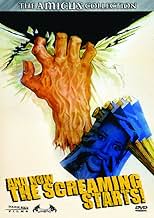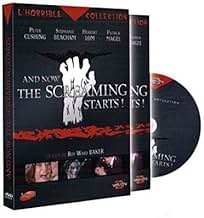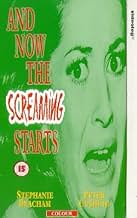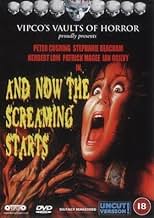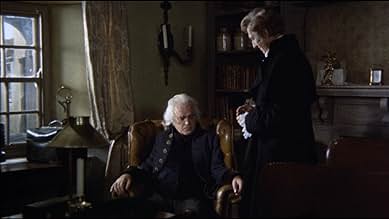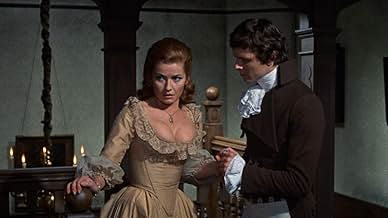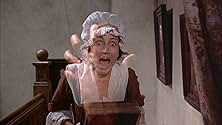Füge eine Handlung in deiner Sprache hinzuEngland, 1795: the young Catherine has just married Charles Fengriffen and moves into his castle. She becomes the victim of a curse that was laid on the family long ago. On her wedding night... Alles lesenEngland, 1795: the young Catherine has just married Charles Fengriffen and moves into his castle. She becomes the victim of a curse that was laid on the family long ago. On her wedding night she is raped by a ghost and gets pregnant.England, 1795: the young Catherine has just married Charles Fengriffen and moves into his castle. She becomes the victim of a curse that was laid on the family long ago. On her wedding night she is raped by a ghost and gets pregnant.
- Regie
- Drehbuch
- Hauptbesetzung
Empfohlene Bewertungen
The film was originally based on an obscure novella entitled `Fengriffin,' after the name of the cursed family line around which the story centers. Of course, a movie called `Fengriffin' would have been a weak seller in any market, particularly the lurid horror market of the early 1970's, (`Texas Chainsaw Massacre' came out only two years after), so it was inevitable that a splashier title would be selected. In choosing `And Now the Screaming Starts', the producers assured their film cult status and greatly embarrassed most of the actors, who had thought they were working on a more `serious' film. The title seems to fit well, however, as lovely Stephanie Beacham demonstrates her lung capacity often, particularly in the first third of the film.
The story follows a standard plot of Gothic decadence: a noble family is cursed for the libertine debauches of an ancestor, and the young generation pays the price. This is typical of a period in literature in which wistful nostalgia for the aristocracy was combined with growing class resentment and a sense that the nobility had `failed' in their responsibilities as leaders. Amicus updates this by including an axe murder, a rotten corpse-ghost with no eyes, a severed hand, and a somewhat overly subtle rape scene by said ghost. The rape is particularly typical of Amicus' approach to the genre, as compared to Hammer's. At the time, Hammer was doling out overt doses of sex alongside their blood, and frontal nudity was not uncommon. Amicus, however, shied away from nudity or sex almost prudishly, and refused to allow its stars to be seen as compromised. Why they would select a story that hinges on a rape they refused to show (or even imply effectively) is perhaps the greatest mystery.
The true star of this movie is the female victim, often the case in well produced Gothic drama. Top-billed Peter Cushing appears 47 minutes into the movie as her doctor, an `ahead-of-his-time' psychiatrist who wants to prove that the supernatural elements are all in her head. The filmmakers have given us a few too many clues at this point for there to be any real doubt, but watching him methodically seek a rational answer (and his excellent downplayed performance) gives the plot a new lease on life after it begins to drag a bit. Patrick Magee as the eccentric country doctor and Herbert Lom as the decadent ancestor are also excellent. A bit less convincing are Ian Ogilvy as the concerned husband and Geoffrey Whitehead as the outraged peasant.
Overall, the film is directed well, nicely photographed, and has beautiful sets and good effects, considering the low budget. Nevertheless, it seems to lack `something' that would make it worthy of repeat viewings. The sense of dread one associates with the best of Gothic drama is undermined somewhat by the romantic, upbeat score. Perhaps there are too many scenes shot in daylight, or the castle isn't quite gloomy and decrepit enough to transmit the sense of the curse. Whatever it may be, I recommend this more as a curiosity than a great film.
Despite the rather jokey title, complete with exclamation mark, this is not a horror spoof along the lines of "Carry On Screaming". Nor, despite the presence of Cushing in the cast, is it a Transylvanian tale of vampires and werewolves. It is rather a Gothic ghost story reminiscent of the work of M R James, although more sexually explicit than anything James would have been allowed to write. The action takes place in the year 1795. A young married couple, Charles and Catherine Fengriffen, move into the stately home of the Fengriffen family. At first the marriage seems a happy one, but soon Catherine is troubled by strange dreams and visions, all of which seem to be connected with Silas, the mysterious and sinister woodcutter who lives in a cottage on the estate, and a portrait of Charles's grandfather, Sir Henry. She comes to believe that the house is haunted and that there is a curse on the Fengriffen family. Several people who try to help her meet mysterious deaths. Eventually Charles admits to Catherine, who is by now pregnant, that there is a legend of a family curse, connected to a terrible crime committed by Sir Henry.
Despite his being the most established star among the cast, Cushing's part is a relatively small one; he plays a doctor brought in to try and cure Catherine of what her husband believes is a mental illness and fulfils that common role in horror films, the rationalist sceptic whose scepticism is inevitably proved wrong by events. Cushing is, however, very good in his role, and there is also a good performance from Herbert Lom as the cruel and debauched Henry, whose crime is seen in flashback. Stephanie Beacham was previously best known to me as Sable in that "Dynasty" spin-of "The Colbys", but here we get to see just how strikingly beautiful she was as a young woman.
Some of the productions of the British horror cycle could be awful, and Cushing, although a talented actor, often found himself cast in the worst of them. ("The Blood Beast Terror" from 1967 and "The Satanic Rites of Dracula", also from 1973, are two particularly dire examples). "And Now the Screaming Starts!", however, is one of the better ones. Its plot may be far-fetched, but all films in this particular genre require a large amount of suspension of disbelief on the part of the viewer, and director Roy Ward Baker, who in the latter part of his career tended to specialise in horror, is able at times to conjure up a quite genuine sense of terror. Moreover, some of the most powerful scenes are those seen in flashback, and here no suspension of disbelief is needed. Ghosts may or may not exist; men as depraved as Sir Henry undoubtedly do, which from my point of view makes them far more frightening than any ghost. This is a highly watchable film, especially when seen late at night. 7/10
A goof. The Fengriffen mansion is built in the Victorian Gothic style, quite anachronistic for a film set in the late 18th century. The actual house used, Oakley Court in Berkshire, was in fact not built until 1859. The film-makers, however, clearly felt that Gothic architecture was much more in keeping with the mood of a horror film than Georgian classicism would have been.
A word to the excellent music, beautiful but interspersed with a spooky zither. And Geoffrey Whitehead is very good. The graveyard climax is pretty powerful too, and the closing shot as a camera wanders an empty room to the Bible is a cut above what one expects from this genre. The bad points are the tacky severed hand, the occasional Grand Guignol hamminess and the fact that the film does rather overplay it's hand...it spends so long building up to its revelation that by then it will always be a let down.
And one other criticism...Catherine recovers from her wedding night ordeal ridiculously quickly, which totally contradicts the film's central premise. Still, the open window symbolism and the Malleus Mallificarum references are neat, as is the wonderful scene of Charles standing by the window as the snow falls and reading the lines from Milton's Comus. This film honestly isn't as bad as you may think and you could certainly do alot worse on a dark winter evening!
Wusstest du schon
- WissenswertesThe film was shot at Oakley Court, a Victorian Gothic country house in Berkshire, England, which previously was the home of Hammer Films. Three years later, Rocky Horror Picture Show (1975) would also be filmed there.
- PatzerThe ghostly hand is a right hand throughout the film, but when it appears to kill Mrs. Luke, it is suddenly a left hand.
- Zitate
[Charles explains that his family's ancestral manse is haunted]
Charles Fengriffen: Ghosts galore. Headless horsemen, horseless headsmen, everything.
- Alternative VersionenUS version is missing two scenes from the original British release: Peter Cushing's discovery of an eyeless corpse and Ian Ogilvy's smashing the skeleton against a gravestone.
Top-Auswahl
- How long is And Now the Screaming Starts!?Powered by Alexa
Details
- Erscheinungsdatum
- Herkunftsland
- Sprache
- Auch bekannt als
- Embryo des Bösens
- Drehorte
- Oakley Court, Windsor Road, Oakley Green, Windsor, Berkshire, England, Vereinigtes Königreich(exterior - Fengriffen Castle)
- Produktionsfirma
- Weitere beteiligte Unternehmen bei IMDbPro anzeigen
- Laufzeit1 Stunde 31 Minuten
- Sound-Mix
- Seitenverhältnis
- 1.85 : 1
Zu dieser Seite beitragen



